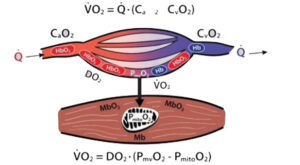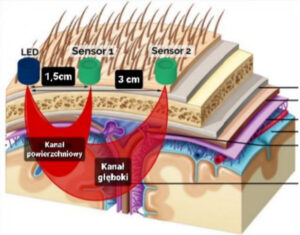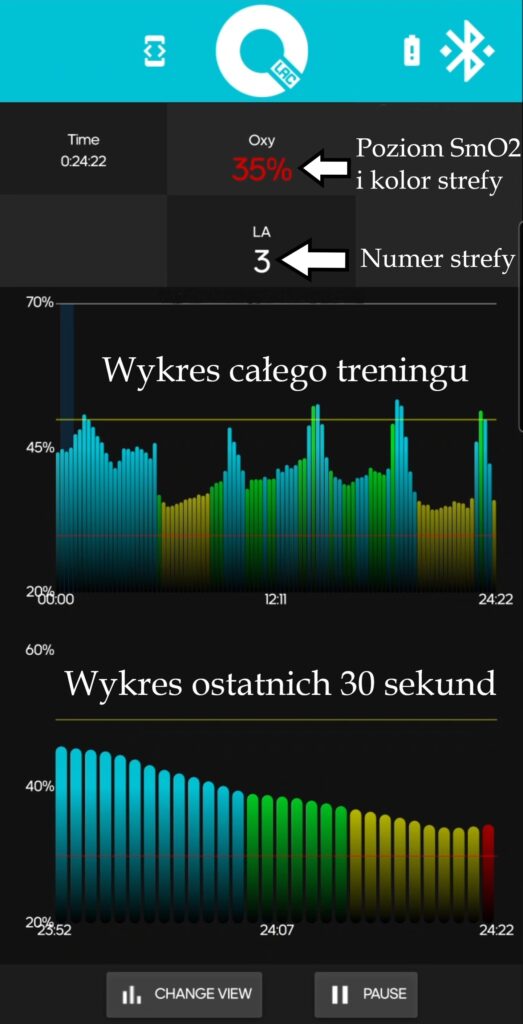Q-LAC
FREQUENTLY ASKED QUESTIONS
1. What is muscle oxygenation variability (SmO2) and how do we study it?
 Muscle oxygenation variability (tissue saturation - SmO2) is ratio of oxygen supplied to a particular tissue (muscle) in terms of consumption of this oxygen in connection with the work performed.
Muscle oxygenation variability (tissue saturation - SmO2) is ratio of oxygen supplied to a particular tissue (muscle) in terms of consumption of this oxygen in connection with the work performed.
The more intensively our muscles work, the more oxygen they consume and need to function properly. We are constantly striving to maintain homeostasis (balance). When a muscle begins to work more intensively, the body tries to compensate for the increased demand with an increased supply of oxygenated blood.
When it is unable to do this because the muscle is working too intensively, oxygenation decreases and lactate concentration, among other things, increases.
 Technology NIRS (near infrared specroscopy) by light emitted by the transmitting LED and collection of emitted light analyses haemoglobin parameters using detectors spaced at two lengths.
Technology NIRS (near infrared specroscopy) by light emitted by the transmitting LED and collection of emitted light analyses haemoglobin parameters using detectors spaced at two lengths.
On a 1.5cm channel where the light penetrates shallower and on a 3cm channel where the light penetrates deeper into the tissues.
The results, which are collected 8 times per second, allow real-time evaluation of the changes occurring in both shallow and deep tissue layers in order to obtain the correct result, presented in real time in the application.
2. What is Total Haemoglobin (THb)?
 Total haemoglobin is the total volume of haemoglobin in the tissue (muscle) examined.
Total haemoglobin is the total volume of haemoglobin in the tissue (muscle) examined.
In our case, we are interested in magnitude of change of this parameter during exercise. Change expressed as a percentage "%". Changes in the value to "+" indicate an increase in the volume of THb, and opposite values "-" a decrease in this parameter. Analysis of THb changes allows us to assess cardiovascular fitness and how the body copes with oxygen deficits in the event of increased exertion.
Im higher THb growth during training this better, this means that our body is able to more efficiently compensate for the increased oxygen consumption by supplying more oxygen via oxygenated blood (with which the so-called 'muscle pumping' is associated).
The longer the body is able to compensate for the increased oxygen demand, the longer we remain in a state of homeostasis and any metabolic thresholds are exceeded at higher intensities.
3. I cannot log into my account.
The following suggestions can help you identify the reason:
- When you registered your account, did you email verification?
- Make sure you have a connection to Internet.
- Check that after the automatic insertion of an email from the phone dictionary, after the email no "space" substituted which results in an incorrect format for the e-mail address entered.
4 The application does not find devices via bluetooth.
When you first launched the app, did you allow access to Bluetooth and location information?
If not, include Bluetooth and location and restart the application.
5. unable to start training.
To begin with, do the INTRO TRAINING, to know the extent of your oxygenation. This workout is described on our channel on YouTube Q-LAC run.
If you don't want perform at the beginning of training INTRO, run it for a few seconds, save to memory by clicking "SAVE" - then all modes will already be available.
6. How to position the sensor correctly?
 Primary placement is 1/3 of the height of the lateral head of the quadriceps.
Primary placement is 1/3 of the height of the lateral head of the quadriceps.
Alternative placement is 1/3 of the height of the middle head of the quadriceps muscle.
You can find more about this in the instructions in the video called "5. Correct mounting + collecting references".
7. what is a reference, how long does it take and how do you make a reference?
During reference collection, the values of parameters such as (oxy haemoglobin, deoxy haemoglobin and total haemoglobin volume) in muscle at rest are analysed.
All changes These parameters, which are indicated during training, are related to the to reference values collected at the start of training, which is why it is so important that the reference is always collected in the same muscular state, preferably fully rested i relaxed (unstressed).
It lasts exactly 30 seconds. During this time it is advisable not to move, to adopt a relaxed position without tensing the muscles. During the reference collection, the values should not change by more than 1-2%. If the values increase, decrease or "wave" by more than 1-2%, it is worth repeating the reference. This may be related to some work the muscles did before the measurement was triggered, e.g. walking up stairs or still aiming for full restitution after exercise.
You can find more about this in the instructions in the video called "5. Correct mounting + collecting references".
8. Why are my performance zones not being determined correctly and what is calibration?
Calibration consists of correcting interpretation of changes by algorithm.
In the case of poorly delineated intensity zones, it is most likely that the a calibrationso that the zones are indicated accordingly.
If the zones change too late (at high intensity indications, e.g. green zones) in the "Calibration" mode increase base value of '6'.
If the zones change too early (at low intensity indications, e.g. red zones) in the "Calibration" mode reduce base value of '6'.
It is best to perform the calibration training described in the instructions in the video under 'Algorithm calibration mode - tips'.
Click here to see the video instructions.
If you do not have the opportunity to take a blood measurement, do a workout where you will go through low, medium and high intensity. Send it to us to the following address: pomoc@q-lac.pl with a password description of the training performed and a screenshot of the training from the historical preview. Approximate information about the intensity at which you have exceeded the lactate threshold so far will also be very helpful for us.
Based on this information, we will come back to you with information about the value that should be entered into the calibration mode so that the zones are determined accordingly.
9. during training I see an increase in values instead of a decrease, for what reason?
- Note whether in the course of collecting 30 seconds of references % values significantly have not changed (change>5%). If this is the case, it is worth paying attention to this in future training sessions.
- Check whether sensor has not been placed too high or whether, during the measurement, there was no sensor displacement up the muscle.
- If a problem arises cyclically It is worth considering a change in the location of the sensor to the alternative location (see above - "Where to position the sensor correctly?").
- If none of the above improvements please contact us at: pomoc@q-lac.pl.
10. Does moving the sensor during training make a difference?
- Sensor displacement by 0.5-1cm during training, except in extreme cases there is no larger meanings.
- Sensor displacement by more than 2-3cm may have significant impact on the quality of the measurement, which is why it is so important to correct fixing.
11. does it matter which leg I place the sensor on?
How the muscles work in both legs is never 100% identical. Therefore, for the sake of repeatability of measurements It is always worth doing workouts with a sensor on the same leg. If for some reason this is not possible, try to place the sensor in a place corresponding as exactly as possible to the same location on the other leg.
12. historical training preview does not work.
Trainings that lasted more than 60 minutes need longer loading times (a few to several seconds).
After clicking in a given training hold with clicking into other elements on the screen.
The workout should load after a while.
The length of loading depends on the length of the workout and the computing power of the device.
In case of further problems, write to us at: pomoc@q-lac.pl
13. What do the colours of the LEDs on the sensor housing mean?
Colour red: battery discharge or other error (software or hardware) - email pomoc@q-lac.pl
Purple: battery charging
Green: full charge batteries and links sensor with the app.
Yellow: during the start of the measurement it indicates signal strength calibration moment light emitted.
Blue: ongoing measurement (light emission from the measuring diode).
14. What do the charts and data presented in the application mean?

Top chart provides a record of of the entire training.
Lower chart presents the changes from last 30 seconds (easier assessment of the trend of change).
"Oxy...%". indicates the level of muscle oxygenation (SmO2) highlighted in zone colour in which we currently reside.
"LA..." indicates zone number which zone we are in (0 - blue zone, 1 - green, 2 - yellow, 3 - red, 4 - purple).
In the training summary, the zones are numbered "1" higher, i.e. between 1 and 5.
